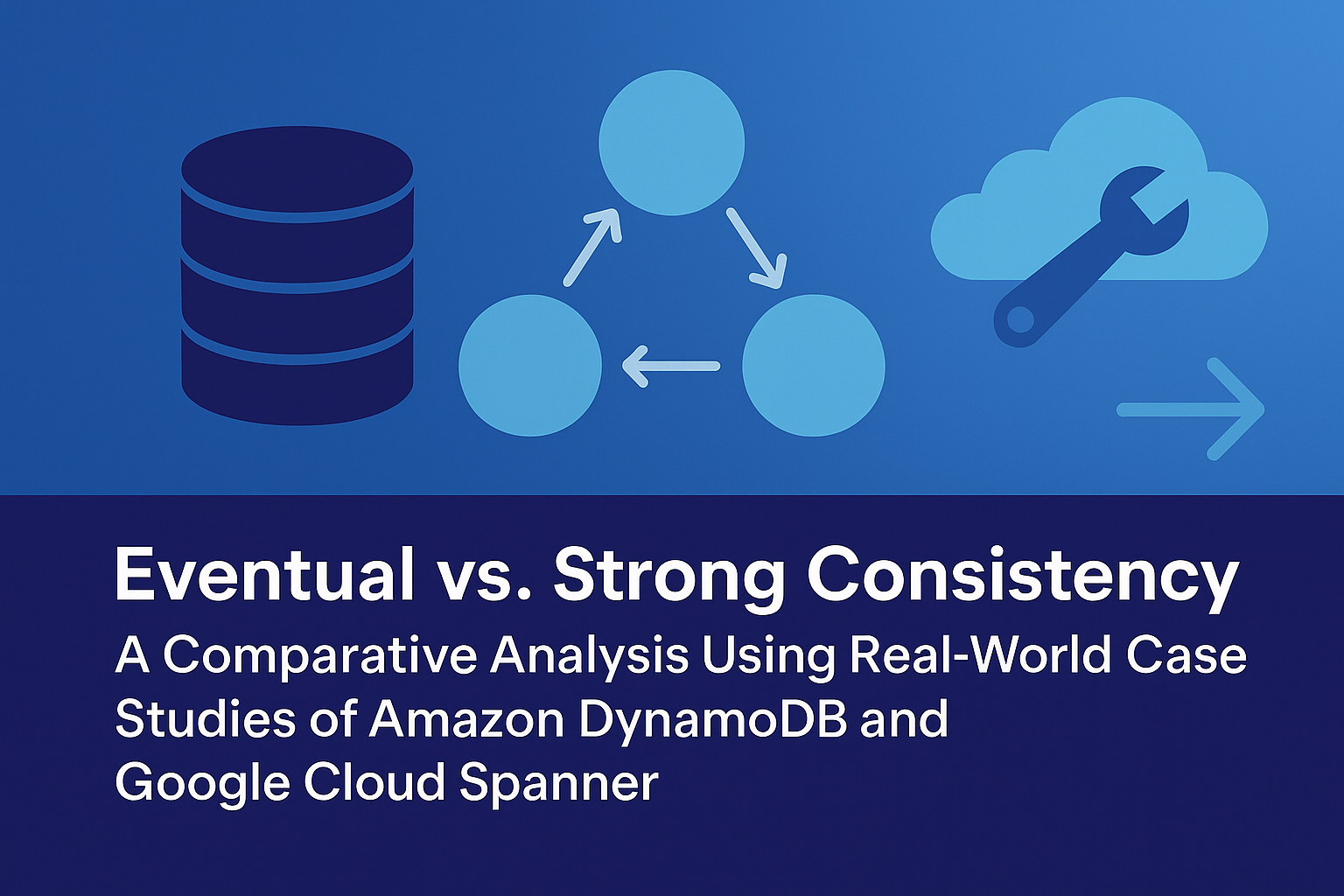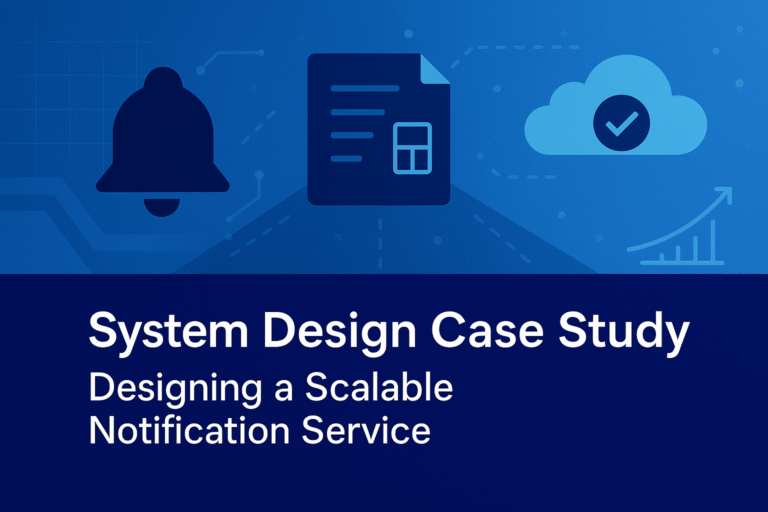Consistency models in distributed systems define the guarantees provided for data reads and writes across multiple nodes, directly influencing system behavior under normal operation and during failures. Two prominent models are eventual consistency and strong consistency. Eventual consistency allows temporary discrepancies between nodes, with the assurance that all nodes will eventually converge to the same state if no new writes occur. In contrast, strong consistency ensures that every read returns the most recent write, providing a linearizable view of the data across the system. This analysis compares these models in detail, using Amazon DynamoDB as a case study for eventual consistency and Google Cloud Spanner for strong consistency. The discussion examines their mechanisms, applications, advantages, limitations, performance metrics, and trade-offs, drawing on principles from the CAP Theorem, replication strategies, and real-world operational considerations to provide a structured understanding for system design professionals.
Mechanisms of Consistency Models
Consistency models dictate how data updates are propagated and how reads are served in distributed systems, balancing the CAP Theorem’s constraints (Consistency, Availability, Partition Tolerance). Partition tolerance is non-negotiable in practical systems, forcing a choice between prioritizing consistency or availability.
- Eventual Consistency:
- Core Mechanism: Writes are applied to a subset of nodes (e.g., a single replica) and propagated asynchronously to others. Reads may return stale data until all nodes converge, typically through anti-entropy processes like read-repair or gossip protocols. Conflict resolution often uses last-write-wins, vector clocks, or CRDTs (Conflict-free Replicated Data Types) to handle concurrent updates.
- Mathematical Foundation: The convergence time is bounded by replication lag, where lag ≈ max(network_delay + processing_time) across replicas. For N replicas, convergence probability approaches 1 as t → ∞, but practical lag is 10–100ms. Staleness probability P(stale) ≈ replication_lag / read_frequency.
- Fault Tolerance: During partitions, the system remains available but may serve inconsistent data, aligning with AP systems in CAP.
- Strong Consistency:
- Core Mechanism: Writes must be acknowledged by all (or a quorum of) nodes before completion, ensuring linearizability—every read sees the latest committed write. This is achieved through synchronous replication, two-phase commit (2PC), or consensus protocols like Paxos or Raft, with conflict avoidance via locks or versioning.
- Mathematical Foundation: Write latency = max(replica_ack_time), typically 10–50ms for quorum W = ⌊N/2⌋ + 1. Read latency is similar for R = ⌊N/2⌋ + 1 to ensure R + W > N. Fault tolerance is up to ⌊(N-1)/2⌋ failures without losing consistency.
- Fault Tolerance: During partitions, the system may reject requests to preserve consistency, aligning with CP systems in CAP.
These mechanisms highlight the trade-off: eventual consistency prioritizes low-latency availability, while strong consistency emphasizes data accuracy at the expense of potential unavailability.
Applications
Eventual consistency is suited for applications where availability and performance are prioritized over immediate data accuracy, while strong consistency is essential for systems requiring precise, linearizable operations.
- Eventual Consistency: Used in content delivery (e.g., social feeds, product recommendations) and caching, where brief staleness is acceptable but downtime is not (e.g., Twitter timelines or Amazon product listings).
- Strong Consistency: Applied in financial systems, inventory management, or coordination services where stale data could lead to errors (e.g., banking transactions or distributed locks).
Advantages and Limitations
Eventual Consistency:
- Advantages:
- High Availability: Systems remain responsive during failures or partitions, achieving 99.99% uptime (e.g., Cassandra serving reads from any node).
- Low Latency: Asynchronous replication enables < 10ms reads/writes, supporting high-throughput workloads (e.g., 1M req/s in DynamoDB).
- Scalability: Decoupled nodes allow horizontal scaling without coordination overhead, reducing costs (e.g., $0.25/GB/month for DynamoDB eventual reads vs. higher for strong).
- Flexibility: Suitable for global systems with variable network conditions.
- Limitations:
- Staleness Risk: Temporary inconsistencies (10–100ms lag) can lead to user-visible errors (e.g., outdated inventory).
- Conflict Management: Requires resolution mechanisms (e.g., last-write-wins adds 10–20% overhead).
- Data Loss Potential: Asynchronous writes risk losing recent data during crashes (e.g., < 1s with replication buffers).
- Unpredictability: Harder to reason about system state, complicating debugging.
Strong Consistency:
- Advantages:
- Data Accuracy: Guarantees linearizability, preventing errors in critical operations (e.g., no double-spending).
- Predictability: Simplifies application logic, as reads always reflect the latest writes.
- Compliance: Meets regulatory needs for data integrity (e.g., GDPR, SOX).
- Fault Tolerance: Tolerates failures while maintaining consistency (e.g., up to ⌊(N-1)/2⌋ failures).
- Limitations:
- Higher Latency: Synchronous coordination adds 10–50ms (e.g., quorum waits in Spanner).
- Reduced Availability: Partitions cause unavailability, as requests may be rejected (e.g., 99.9% uptime vs. 99.99%).
- Scalability Constraints: Coordination limits throughput (e.g., 50,000 req/s vs. 1M for eventual).
- Complexity: Requires consensus protocols (e.g., Paxos in Spanner) and conflict avoidance (e.g., locking).
Real-World Case Studies
Case Study 1: Amazon DynamoDB (Eventual Consistency)
Amazon DynamoDB is a fully managed NoSQL database that defaults to eventual consistency, making it highly available and scalable for e-commerce workloads.
- Context: DynamoDB supports millions of requests per second across global tables, handling variable traffic in Amazon’s ecosystem (e.g., 10M product views/day).
- Implementation:
- Consistency Model: Eventual consistency for reads (default), with an option for strong consistency via ConsistentRead=true.
- Mechanism: Asynchronous replication across replicas (N=3 by default), with read-repair and hinted handoff for convergence. Conflicts resolved via last-write-wins.
- Integration: Uses consistent hashing for partitioning, Change Data Capture (CDC) via DynamoDB Streams for cache invalidation in Redis, Bloom Filters to reduce unnecessary reads, and rate limiting with Token Bucket to prevent overload.
- Failure Handling: Heartbeats for liveness detection (< 3s timeout), idempotency with unique IDs (e.g., UUID for request keys), and load balancing (Least Connections) for traffic distribution.
- GeoHashing: Applied to location-based data for efficient querying in global tables.
- Security: AES-256 encryption, checksums (SHA-256) for data integrity, and IAM for access control.
- Performance Metrics:
- Latency: < 10ms for eventual reads, 10–50ms for strong reads.
- Throughput: Up to 100,000 req/s per table (provisioned mode).
- Availability: 99.99% with multi-AZ replication.
- Staleness: < 100ms convergence time.
- Cache Hit Rate: 90–95% with Redis integration, reducing DynamoDB load by 85%.
- Trade-Offs:
- Prioritizes availability and low latency for non-critical reads (e.g., product metadata), accepting eventual consistency to avoid blocking during partitions.
- For critical operations (e.g., inventory updates), switches to strong consistency, increasing latency but ensuring accuracy.
- Strategic Considerations: DynamoDB’s tunable consistency allows hybrid approaches—eventual for high-throughput analytics, strong for transactions—making it ideal for Amazon’s mixed workloads. Use CDC to propagate changes and maintain eventual consistency, with Bloom Filters to optimize reads.
Case Study 2: Google Cloud Spanner (Strong Consistency)
Google Cloud Spanner is a globally distributed relational database that provides strong consistency through TrueTime and multi-Paxos replication, ensuring linearizable operations across regions.
- Context: Spanner supports mission-critical applications, such as financial transactions and ad processing at Google, handling billions of queries per day with global consistency.
- Implementation:
- Consistency Model: Strong consistency (linearizability) for all reads/writes, with external consistency across transactions.
- Mechanism: Uses TrueTime (atomic clocks with bounded uncertainty, < 7ms) to timestamp transactions, ensuring global ordering. Writes use multi-Paxos for consensus across replicas, with read quorums (R = ⌊N/2⌋ + 1) and write quorums (W = ⌊N/2⌋ + 1) to guarantee R + W > N.
- Integration: Consistent hashing for data partitioning, CDC via Spanner Change Streams for cache updates in Redis, Bloom Filters to reduce query overhead, rate limiting with Token Bucket for API access, and GeoHashing for location-based analytics.
- Failure Handling: Heartbeats for liveness detection (< 3s timeout), idempotency with unique IDs (e.g., Snowflake for transaction keys), and load balancing (Least Response Time) for query distribution.
- Security: AES-256 encryption, checksums (SHA-256) for data integrity, and IAM for access control.
- Performance Metrics:
- Latency: < 50ms for global reads/writes (TrueTime minimizes clock skew).
- Throughput: 100,000+ req/s per database, scaling with nodes.
- Availability: 99.999% with multi-region replication.
- Staleness: 0ms (linearizable), no convergence lag.
- Cache Hit Rate: 90–95% with Redis integration, reducing Spanner load by 85%.
- Trade-Offs:
- Prioritizes strong consistency for accuracy, accepting higher latency due to global coordination, but mitigates with TrueTime to bound uncertainty.
- During partitions, it rejects requests to preserve consistency, reducing availability but ensuring no stale reads.
- Strategic Considerations: Spanner’s strong consistency is ideal for applications requiring ACID transactions across regions, like Google’s AdWords, where data accuracy outweighs minor latency increases. Use CDC to propagate changes and integrate with Redis for low-latency caching of frequently read data.
Trade-Offs Between Eventual and Strong Consistency
1. Consistency vs. Latency
- Eventual: Lower latency (< 10ms) due to asynchronous replication but risks staleness (10–100ms).
- Strong: Higher latency (10–50ms) due to synchronous coordination but ensures 0ms staleness.
- Decision: Use eventual for read-heavy apps (Twitter feeds), strong for write-critical (PayPal transactions).
- Mitigation: Use caching (e.g., Redis Cache-Aside) to reduce effective latency in strong consistency systems.
2. Availability vs. Data Accuracy
- Eventual: High availability (99.99%) during partitions but potential inaccuracies (e.g., stale DynamoDB reads).
- Strong: Reduced availability during partitions (requests rejected) but high accuracy (e.g., Spanner linearizability).
- Decision: Use eventual for user-facing content (Amazon listings), strong for financial data (PayPal balances).
- Mitigation: Heartbeats (< 3s detection) and failure handling (retries, fallbacks) to minimize downtime.
3. Scalability vs. Complexity
- Eventual: Scales to 1M+ req/s with decoupled nodes but requires conflict resolution (e.g., last-write-wins adds 10–20% overhead).
- Strong: Limits scalability (100,000 req/s) due to coordination but simplifies application logic (no conflict handling needed).
- Decision: Use eventual for high-scale systems (Twitter), strong for moderate-scale (PayPal).
- Mitigation: Consistent hashing for load distribution, idempotency for safe retries in eventual systems.
4. Cost vs. Performance
- Eventual: Lower costs with async replication (e.g., $0.25/GB/month for DynamoDB eventual reads) but potential staleness mitigation costs (e.g., CDC overhead).
- Strong: Higher costs due to sync coordination (e.g., $0.50/GB/month for strong reads) but ensures performance in critical paths.
- Decision: Use eventual for cost-sensitive analytics (Twitter), strong for high-value transactions (PayPal).
- Mitigation: Rate limiting (Token Bucket) to control costs, GeoHashing for efficient querying.
5. Fault Tolerance vs. Overhead
- Eventual: High fault tolerance (up to N-1 failures with replicas) but risks data loss (e.g., < 1s in async replication).
- Strong: Fault tolerance up to ⌊(N-1)/2⌋ failures but higher overhead (10–20% CPU for quorum).
- Decision: Use eventual for high-availability systems, strong for consistency-critical.
- Mitigation: Heartbeats for failure detection, checksums (SHA-256) for integrity.
Advanced Implementation Considerations
Eventual Consistency Implementation
- Deployment: Use AWS DynamoDB or Cassandra clusters with 10 nodes (16GB RAM).
- Configuration:
- DynamoDB: ConsistentRead=false, Global Tables for multi-region replication.
- Cassandra: ConsistencyLevel.ONE, NetworkTopologyStrategy.
- Optimization: Use Redis for caching with Cache-Aside, Bloom Filters to reduce stale reads, GeoHashing for analytics.
- Monitoring: Track staleness (< 100ms) and latency with Prometheus.
- Testing: Simulate partitions with Chaos Monkey to validate availability.
Strong Consistency Implementation
- Deployment: Use Google Cloud Spanner or MongoDB replica sets with 5 nodes (16GB RAM).
- Configuration:
- Spanner: TrueTime for linearizability, multi-Paxos for quorums.
- MongoDB: majority write concern, primary read preference.
- Optimization: Use Redis for caching with Write-Through, idempotency for safe writes, unique IDs (Snowflake) for versioning.
- Monitoring: Track quorum latency (< 50ms) and failover time (< 10s) with Grafana.
- Testing: Validate linearizability with Jepsen tests.
Strategic Considerations for System Design
- Application Sensitivity: Use strong consistency for error-intolerant apps (e.g., finance), eventual for performance-sensitive (e.g., feeds).
- Hybrid Models: Leverage tunable systems (e.g., DynamoDB) for per-operation consistency.
- Mitigating Staleness: Use read-repair, anti-entropy, or caching in eventual systems.
- Cost-Benefit: Eventual consistency lowers costs ($0.25/GB/month) but requires conflict handling; strong consistency ensures accuracy at higher costs.
- Scalability Planning: Eventual consistency scales better (1M req/s) but needs idempotency for retries; strong consistency limits scale but simplifies logic.
- Interview Strategy: Justify eventual for Twitter (e.g., “Availability for feeds with 10–100ms lag”), strong for PayPal (e.g., “Consistency for transactions”).
Conclusion
Eventual and strong consistency models represent essential trade-offs in distributed system design, with eventual consistency providing high availability and low latency at the risk of temporary staleness, and strong consistency ensuring data accuracy at the expense of potential unavailability and higher latency. Case studies of Amazon DynamoDB (eventual consistency) and Google Cloud Spanner (strong consistency) illustrate these models in practice, demonstrating how they address real-world requirements for scalability, reliability, and performance. By integrating with techniques like CDC, caching, idempotency, and quorum-based mechanisms, architects can mitigate limitations and achieve balanced systems. Strategic selection based on application needs—eventual for user-facing features like feeds and strong for critical operations like transactions—ensures robust, scalable designs for distributed environments.




